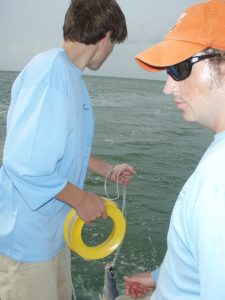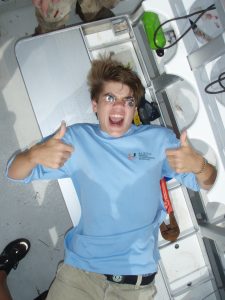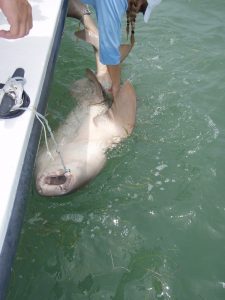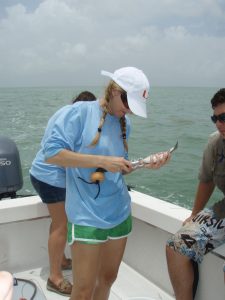Day two of CNN Interview and Shark Research…
June 27, 2010
The combination of an early morning rise to make the drive from Miami to Islamorada and the thrill of my first day out with the shark team made for an early bedtime on the eve of today’s trip. I awoke refreshed after 10 hours of sleep and was good to go for day two of shark weekend number one of my internship. The clouds and sun shared the sky and there was a nice breeze to keep us somewhat comfortable as we arrived at the Keys Marine Lab dock. We then prepared the boat for what could be, an amazing day of shark research!
As we cruised away from the dock yesterday, my excitement was slightly dampened by some feelings of cluelessness. After one day on the water and 7 sharks under my belt, I by no means considered myself an expert just yet. However, I felt much more confident in what to expect and was able to be genuinely excited for what was to come. We had the other half of the Lakeview Academy high school students from Gainesville, GA to help us for the day and they were determined to catch more sharks than their classmates had the day before. Again, the bar was set at seven.

Dr. Hammerschlag helping Lakeview high school students set out the baited drumlines. (click to enlarge)
One of our other guests on board had a different goal in mind. After failing to catch any of the big three (bulls, hammerheads and tigers) to satellite tag the day before, 2/3 of the CNN crew had to move on to document another story. The crew left their producer to complete and wrap up the story. CNN was with us this weekend to report on the research conducted by Dr. Hammerschlag and his shark team and its potential to determine the effects the Gulf oil spill will have on sharks in the area. They were particularly interested in our satellite tagged sharks like Hurley, to track the animals’ movements as the oil moves throughout the gulf. Kim Seagal, CNN producer, was hoping to obtain footage of us attaching a satellite tag to a shark, but unfortunately we did not meet Kim’s goal. Even despite our “hammer cheers” and enthusiasm from our Lakeview “researchers for a day”, we did not bring in any bulls, tigers or hammerheads.

A Lakeview student hoping to imitate sharks using a “fish-eye view” that would help bring in the big ones. (click to enlarge)
We were however able to tie yesterday’s catch, totaling seven sharks for the day. We figured that would provide for a more pleasant 12 hour drive back to Georgia, now that the student’s had shark catching bragging rights. The catch consisted of a blacktip, a blacknose, a lemon and four nurse sharks.

This pump flushes water over the sharks’ gills while the data for the animal is being collected. (click to enlarge)
Unlike yesterday, the students were able to experience the challenge of working with “enthusiastic” nurse sharks, moving quickly to place a spaghetti tag or sneak in a length measurement when the animal decided to stop rolling. However challenging they are to work with they are equally as beautiful with their impressive brown coloring and muscular bodies.

Caroline working to tame one of the nurse sharks mid-roll so we are able to collect the data. (click to enlarge)
Although the shark count for each day remained at seven, the fish count in our three fish traps set a new record – 150 pinfish in a single trap!!!! We are setting the traps out to determine the fish community composition near the areas we are catching sharks. This will give us some idea of the menu these sharks have to choose from. We needed all hands on to get the fish back in the water quickly. Squeamish at first, the students picked up “pinfish handling and release 101” very quickly, but Caroline proved to be our fish release champion. I think she may have had a bit more practice with this than the rest of us. We also caught a very upset puffer fish baring some impressive teeth. Don’t worry, the puffer had deflated by the time it ended up back in the water and looked to be in good condition.

Caroline measuring a commercially important fish, while pinfish a non commercially important specie is being tossed back. (click to enlarge)
When the last drumline was pulled in and all the fish were released, we headed back to the dock with one producer diligently typing away to wrap up the story and a boatload of exhausted students and interns. 14 sharks in two days! No wonder everyone was wiped out. The shark team ended the day with some pizza and watching the 2 minute and 17 second story on CNN back at Captain Curt’s. If you missed it on air, you can check it out online!

We were all pretty worn out after seven sharks and over 200 fish! Catching a few zzz’s before we docked at the lab. (click to enlarge)
Four different sharks species and fourteen total individual animals in two days, not a bad way to start out, but it looks like I will have to wait for another trip to deploy my first satellite tag. Can’t wait to get back out on the water again!
Thank to everyone that helped out and to CNN for bringing attention beyond the ocean’s surface and coastline to life underwater and the challenges our sharks are facing. Feel free to check out the CNN interview for the RJ Dunlap Program at CNN INTERVIEW.
Until the next adventure,
Rachael Kraemer (Shark Program Intern)

Leave a Reply
Want to join the discussion?Feel free to contribute!